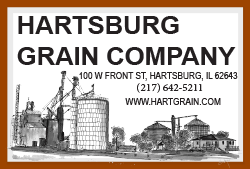|
Logan County Board takes first
steps in acquiring courthouse restoration funds
Board members given option to
meet virtually during Covid
 Send a link to a friend
Send a link to a friend
 [April 17, 2020]
On Wednesday, March 25th, the
Logan County Board held a special meeting taking action on several
timely matters. On the agenda were a couple actions to initiate the
acquisition of funds for the Logan County Courthouse restoration.
The board also needed to formalize the County Emergency Proclamation
Declaration for Covid-19. [April 17, 2020]
On Wednesday, March 25th, the
Logan County Board held a special meeting taking action on several
timely matters. On the agenda were a couple actions to initiate the
acquisition of funds for the Logan County Courthouse restoration.
The board also needed to formalize the County Emergency Proclamation
Declaration for Covid-19.
File request for sales tax collection with state
During the primary held on March 17th voters approved a half-cent
sales tax for up to 20 years. The referendum stated that the revenue
would be dedicated to a public facilities fund for the restoration
and repairs of the courthouse. The referendum was the third attempt
at the measure, which passed by 63% with 3,443 yesses.
The state of Illinois needs a copy of the ordinance establishing the
tax before May 1, for the tax to begin being collected on July 1st,
2020. There is about a three-month turnaround period, and then the
county could expect the first check in October or November 2020.
The ordinance to impose a retail’s occupation tax (sales tax) for
the purpose of restoring and repairing the Logan County Courthouse
passed unanimously by the 10 board members present - Dave
Blankenship, Emily Davenport, Bob Farmer, Cameron Halpin, David
Hepler, Steve Jenness, Chuck Ruben, Bob Sanders, Scott Schaffenacker
and Jim Wessbecher. Janet Estill and Annette Welch were absent.
This ordinance requires 15 days display and at the next voting
meeting, Tuesday, April 21st, the board can give final approval.
Then a copy would be sent to the Illinois Department of Revenue.
Bond Ordinance‘notice of intent’ with a 30-day review
The board next went through a series of complex decision-making
steps in the acquisition of General Obligation Bonds. Bond expert
David Pistorius of First Midstate, Bloomington, reviewed the
processes and procedures, and answered questions.
Pistorius said a copy of the referendum question just as it appeared
on the ballot was incorporated into the bond ordinance.

He said there would be several steps yet in the future, including
the final bond ordinance when the bonds are ready to be sold, but
first would be ‘notice of intent’ to go out for bonds.
The following are some of the details that were discussed as
Pistorius explained the ins and outs of the bonding process.
The preferred choice for the county is the use of Alternate Revenue
Source Bonds. They offer the lowest interest rates. With these types
of bonds the borrower (the county) pledges a revenue source to pay
the debt back. The new sales tax is the revenue in this instance.
There needs to be assurance the county would have the funds, so a
25% coverage is required.
1) The coverage can be met by borrowing 25% less than the amount the
sales tax that is expected to bring in each year. This reduces the
amount that may be borrowed.
2) Another (alternate) revenue stream representing the 25% coverage
can be pledged in the case that the sales tax would not be
sufficient any given year.
The Corporate Replacement Tax has a sufficient revenue that could be
listed as the designated source of coverage, but if the sales tax
were to be insufficient, any other revenue source could be decided
at that time.
As an automatic process, each year in November the county would levy
property taxes, and then do an abatement when the sales tax has
covered the bond payment. Property taxes automatically serve as the
last choice backup revenue. If in a given year the sales tax fell
short of the payment (debt service), the board could determine other
revenue to fill in the shortage.

If during the 30-day public viewing of the bond ordinance, a
petition in opposition to the recently approved referendum received
signatures by seven-and-a half percent of Logan County’s 17,796
registered voters, 1,348 signatures, the county has several choices:
put the referendum on the next November ballot for vote again, drop
the project, or consider debt certificates.
Debt certificates are a tax exempt installment contract that do not
go through a petition period. Debt certificates do not require
back-up revenue. Pistorius explained that debt certificates are not
as preferred because they do not have a dedicated alternate revenue
source, which makes them less appealing to investors and the
interest rates would be higher. In an example, debt certificates
might cost the county a half-million dollars more in interest over
the course of the debt period.
A review of Alternate Revenue Certificates
1) By statute, the revenues that are pledged must have a 25%
coverage factor. There needs to be 25% more revenue available than
the amount of the bonds taken out. It is a protective feature to
citizens that property taxes will not be levied, Pistorius said.
2) Once the 30-day period is over the county has the authority to
issue the bonds. That authority is good for three years. Pistorius
explained that the three-year time allows greater flexibility and
options. By way of example he said, you could publish the order of
intent for bonds on the higher side, say $12 million, then only
issue for $10 M in bonds, and if there were cost overruns in that
three years, there would be $2 M still available to cover those
costs.
Pistorius said there were two decisions before the board on the bond
issue for the special meeting: decide the amount to publish and
would any additional revenue besides the public facility sales tax
be committed.
In April or May there would also be a public hearing for the
community to ask about the specifics of the project.

Later yet, the final step would be to set the bond ordinance. Bonds
are sold a week to 10 days prior to the final bond ordinance at
current market values, which would influence the interest rate. This
process might take place in May or June. The county could expect the
proceeds three weeks after the ordinance is filed.
The new sales tax for the court house is in the same increment as
the public safety tax; one-half cent. It would be put into a
designated fund for the sole purpose of the courthouse renovation
and repairs. The Public Safety Tax has been bringing in $938,000 to
$940,000 per year.
[to top of second column] |

However, it was recognized that sales tax revenues could be
significantly impacted by Covid-19. Much is unknown about how sales
taxes might be impacted at this time and about interest rates while
the market is currently turbulent. Pistorius thought that the
economy might be more settled by the time the county would be ready
to go out for bonds in May or June.
Ruben questioned if it
would be ok to get all set up for issuing the bonds and be ready,
but if turmoil was still an issue, the bonding could be delayed a
little bit. Pistorius agreed.
The Public Safety Sales
Tax, which is the same percentage as the new sales tax, has been
coming in $940,000.
Pistorius suggested
using a safer figure of $935,000. Taking the 25% coverage out would
provide $750,000 per year. Any that comes in over the $750,000 from
the sales tax could be utilized for courthouse projects or kept in
the fund to accumulate and later used to pay down the bonds quicker.

Another option, if the
county wants to utilize the full amount of the anticipated sales
tax, $935,000 a year, is to pledge another revenue for the 25%
coverage.
Various interest
rates and bond amounts
Finance Chairman Chuck
Ruben confirmed with Pistorius that later, once the proposed bond
issuance ordinance is enacted, the county has three months to commit
to the bonds. This allows some flexibility to try for the best
interest rate.
Pistorius said that
prior to covid, the bond market held some of the lowest rates he’d
seen in his career. Mid-March he did a bonding at 1.23%, however the
market is volatile right now. It is hard to say where interest rates
will be when Logan County is ready to go out for bonds. First
Midwest would wait for the dust to settle a bit, and he’d make a
recommendation on when to act.
When looking at to the
debt service (payments), Pistorius prepared two projections based on
how much the county would pledge set at three to five percent
interest rates. Lower rates may be available when it comes time to
bond.
1) The first option
using $750,000 pledged from the sales tax, reserving the anticipated
remainder for the 25% coverage, the county would receive between an
estimated $9.3 M – $11 M in bond amounts.
2) The second option
using $935,000 per year with 25% coverage pledged from the Corporate
Replacement Tax provides a bond issue between $11.6 M - $13.766 M.
As board members
discussed the options, Schaffenacker put forth an amendment seconded
by Hepler for the bond amount not to exceed $9.5 million. Hepler
recalled that before the election, voters were told the costs would
be plus or minus 15% of $7.9 M. Also, the option presented by
Pistorius as an option to include the Corporate Replacement Tax as
the 25% coverage had not been presented to voters either.

Blankenship commented
on the potentially higher construction costs. He said those figures
presented to the public had changed and are now said to be $9.5 M
and the county needed to be prepared to add another 15% due to
construction costs having gone up.
Covid impact was
mentioned in regard to construction costs and interest rate
increases.
The amendment to not
exceed $9.5 M in bonds failed 2 – 8 with Hepler and Schaffenacker
voting yes.
The main motion to
issue General Obligation Bonds in the form of Alternate Revenue
Source to be paid by the newly approved sales tax passed with all
present voting yes.
Board members
recognized that choosing a higher bond amount now for the intent to
issue bonds notice allows opportunity to lower the figure when it is
time to pass the final ordinance to issue bonds when interest rates
and construction costs are better known.
The notice of intent to
issue bonds would be limited to $750,000 debt service for
potentially $11 M in bonds.
Summary
- A specific fund would
be set up for this special tax to go into that designates that funds
can only be used for the courthouse restoration and repairs.
- The sales tax has a
limited time of 20 years.
- Annual overages can
be used for courthouse related projects or accumulated and later put
on early bond pay-off.

Covid-19 Emergency Declaration
All 10 board members
present voted yes to approve the Covid-19 Emergency Declaration.
County Board
meetings during covid
All Logan County Board
committees were canceled for April. Committees will discuss matters
during the Board Workshop tonight, Thursday, April 16th. The Regular
Board session with voting will take place on Tuesday, April 21st.
To protect the board
members and support staff, State's Attorney Bradley Hauge has
continued to look into what actions the board and other entities
subject to public transparency and services are permitted.
In an update on Ap 15th
regarding the Open Meetings Act, Hauge said, “It appears that the
Attorney General is backing the Governor and his executive order.
The AG is now of the opinion that board members do not need to be
physically present, not even a quorum, for all votes to count. It is
my opinion that everything that Logan County is doing is appropriate
and legal, pursuant to the executive order and the guidance given
from the Attorney General’s Office.”
Public meeting guidelines - pdf
Work is underway for
the board members who choose to stay home to interact via a virtual
meeting tool. The meeting will also be streamed live from the Logan
County Facebook page.
[Jan Youngquist]
Ed note: This
discussion took place on March 25 when much less was known
concerning covid impacts. More yet is expected to be known on sales
tax income and interest rates when it comes time to issue bonds,
which is a separate ordinance. |